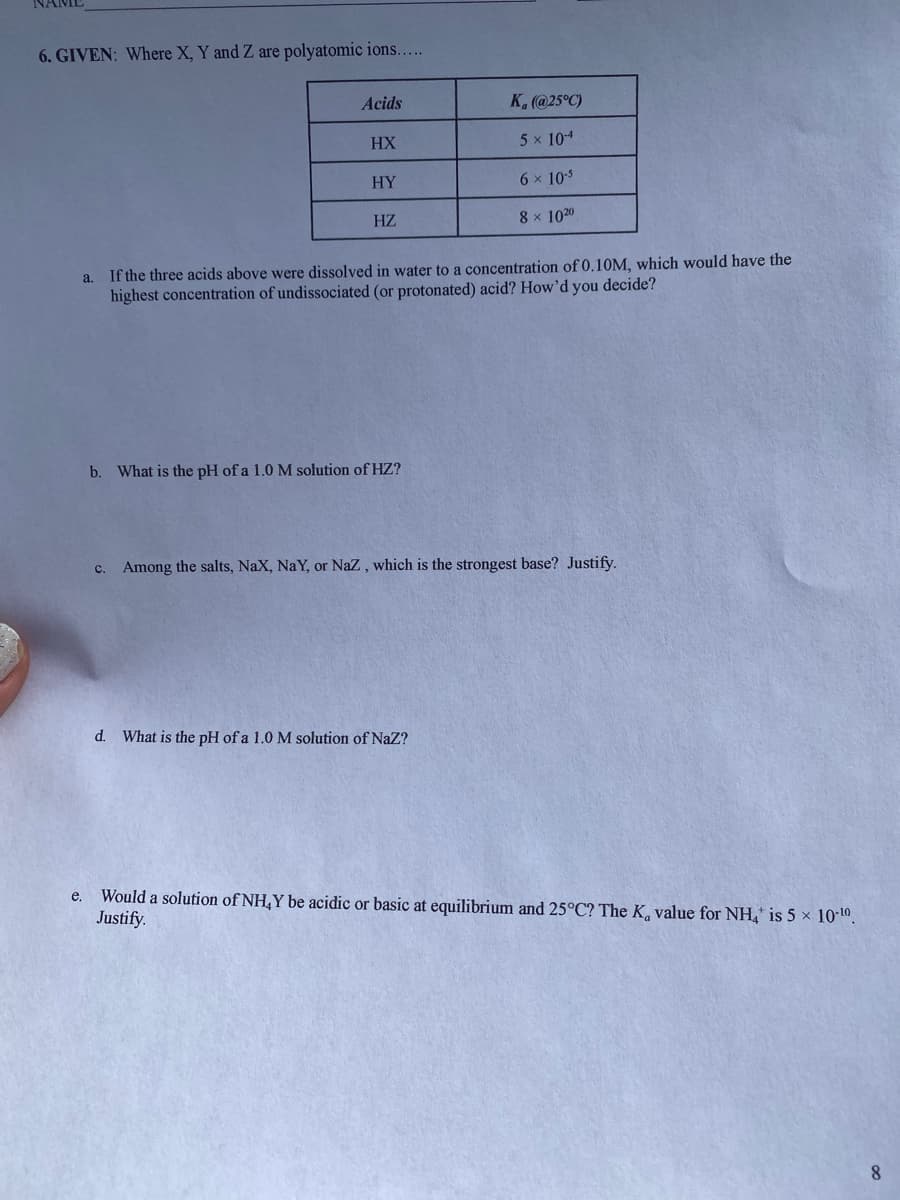NAME 6. GIVEN: Where X, Y and Z are polyatomic ions.. Acids K, @25°C) HX 5 x 104 HY 6 x 10 HZ 8 x 1020 a. If the three acids above were dissolved in water to a concentration of 0.10M, which would have the highest concentration of undissociated (or protonated) acid? How'd you decide? b. What is the pH of a 1.0 M solution of HZ? c. Among the salts, NaX, NaY, or NaZ, which is the strongest base? Justify. d. What is the pH of a 1.0 M solution of NaZ? Would a solution of NH,Y be acidic or basic at equilibrium and 25°C? The K, value for NH, is 5 x 1010. Justify. е.
NAME 6. GIVEN: Where X, Y and Z are polyatomic ions.. Acids K, @25°C) HX 5 x 104 HY 6 x 10 HZ 8 x 1020 a. If the three acids above were dissolved in water to a concentration of 0.10M, which would have the highest concentration of undissociated (or protonated) acid? How'd you decide? b. What is the pH of a 1.0 M solution of HZ? c. Among the salts, NaX, NaY, or NaZ, which is the strongest base? Justify. d. What is the pH of a 1.0 M solution of NaZ? Would a solution of NH,Y be acidic or basic at equilibrium and 25°C? The K, value for NH, is 5 x 1010. Justify. е.
Chapter8: Polyfunctional Acids And Bases
Section: Chapter Questions
Problem 4P
Related questions
Question
Can you help me?

Transcribed Image Text:6. GIVEN: Where X, Y and Z are polyatomic ions...
Acids
K. (@25°C)
HX
5 x 104
HY
6 x 105
HZ
8 x 1020
a. If the three acids above were dissolved in water to a concentration of 0.10M, which would have the
highest concentration of undissociated (or protonated) acid? How'd you decide?
b. What is the pH of a 1.0 M solution of HZ?
Among the salts, NaX, NaY, or Naz , which is the strongest base? Justify.
C.
d. What is the pH of a 1.0 M solution of NaZ?
Would a solution of NH,Y be acidic or basic at equilibrium and 25°C? The K value for NH, is 5 x 10-10.
Justify.
е.
8
Expert Solution
This question has been solved!
Explore an expertly crafted, step-by-step solution for a thorough understanding of key concepts.
Step by step
Solved in 2 steps

Knowledge Booster
Learn more about
Need a deep-dive on the concept behind this application? Look no further. Learn more about this topic, chemistry and related others by exploring similar questions and additional content below.Recommended textbooks for you


Chemistry by OpenStax (2015-05-04)
Chemistry
ISBN:
9781938168390
Author:
Klaus Theopold, Richard H Langley, Paul Flowers, William R. Robinson, Mark Blaser
Publisher:
OpenStax

Chemistry: Principles and Reactions
Chemistry
ISBN:
9781305079373
Author:
William L. Masterton, Cecile N. Hurley
Publisher:
Cengage Learning


Chemistry by OpenStax (2015-05-04)
Chemistry
ISBN:
9781938168390
Author:
Klaus Theopold, Richard H Langley, Paul Flowers, William R. Robinson, Mark Blaser
Publisher:
OpenStax

Chemistry: Principles and Reactions
Chemistry
ISBN:
9781305079373
Author:
William L. Masterton, Cecile N. Hurley
Publisher:
Cengage Learning

Chemistry & Chemical Reactivity
Chemistry
ISBN:
9781133949640
Author:
John C. Kotz, Paul M. Treichel, John Townsend, David Treichel
Publisher:
Cengage Learning


Chemistry
Chemistry
ISBN:
9781305957404
Author:
Steven S. Zumdahl, Susan A. Zumdahl, Donald J. DeCoste
Publisher:
Cengage Learning